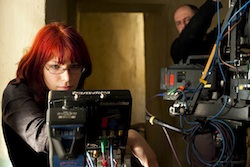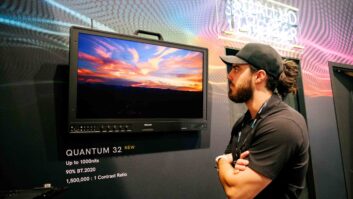
David Fox looks at developments in camera monitors and finds that 3D and OLED technologies are at the forefront of recent R&D.
One of the most interesting introductions in camera monitors this year has been Transvideo’s CineMonitorHD 3DView, the first HD-SDI monitor designed specifically for stereographers shooting 3D on location. It includes diagnostic tools for camera and rig setup, far horizon adjustment and measurement for both cameras.
Flip and flop are available for both inputs, so it will work with parallel or mirror rigs and European or US models. The stereoscopic picture can be monitored in anaglyph, monochrome or with shutter glasses, so that the monitor can be used for 3D preview as well as in 2D. It comes in 6-, 10-, 12- and 15-inch models. Each unit includes measurement tools (waveform, histogram, vectorscope) and a frameline generator. An optional virtual horizon helps Steadicam and hand-held users.
Also new is Transvideo’s CineMonitorHD Evolution, which includes more measurement tools with enhanced resolution, including: waveform with single line, all lines and sweep; parade modes including YPrPb; vectorscope; and histogram.
The monitor accepts extended range cameras with dynamic adjustment, and includes a Cooke i/ lens interface to give a graphic representation of focus, zoom and iris values plus a depth of field calculation. A focus helper based on picture analysis detects the infocus zones in multiple directions.
There are also overexposure and black compression checkers, an equivalent zone indicator, time code reader, audio monitoring and more. An optional virtual horizon is useful for Steadicam applications. “Soon you’ll be able to freeze, store, recall shots, monitor voltage, and check audio. You’ll also be able to remotely dim the Cooke 5/i focus scales from the monitor,” explained Transvideo CEO Jacques Delacoux. It is available in 6-, 8-, 10-, 12- and 15-inch models.
Hawk flies high def
Tamuz has updated its well-known Hawk series of monitors for HD. The new Hawk II series OCM 107W HD uses an OLED display, and has SD/HD-SDI, analogue composite, analogue HD-capable component, and HDMI inputs.
OLED’s big advantage is noticeable in the harsh light of day, where it needs no modification to be viewable, as it has an exceptional contrast range compared to LCDs. Other boasts include: no delays or response time in image presentation; no smear or latency effects; absolute deep black at video signal black; no issues with viewing angles; less weight; and low power consumption.
Screen resolution is 800×480 pixels and brightness is set for the European market to 150 cd/m2nominal, but adjustable in the range of 70 to 200 cd/m2. Contrast is more than 500,000:1 and the black is darker than 0.000.3 cd/m2 (better than the recommended values of EBU t3320 Grade-2 monitors).
Marshall Electronics has also introduced an OLED portable production monitor. The Marshall V-OL761 has a 7.6-inch 800×480 OLED panel, which promises to provide a wider range of colours, gamut, contrast, and brightness. It has a wide 170° viewing angle, low power consumption and fast response time, 200 cd/m² brightness, and a 10,000:1 contrast ratio. It is available in 3GSDI (Composite, YPbPr and 3G/HD/SDI), HDA (Composite, YPbPr), and HDMI (Composite, YPbPr and HDMI) versions, and can be fitted with various battery adapters.
It includes a False Colour filter, to aid in setting camera exposure. As the iris is adjusted, elements of the image change colour based on the luminance or brightness values. This enables proper exposure to be achieved without external test equipment.
The V-LCD651ST is the latest in Marshall’s line of Super Transflective Outdoor Monitors. This 6.5-inch monitor minimizes surface reflection of both outdoor and indoor light, but boasts ‘a much wider colour reproduction range than typical transflective/reflective LCDs or even those with increased backlight performance.’
It weighs 590g, has a 2.4 megapixel screen, four-pin XLR power jack, and optical-grade polycarbonate screen protection. Analogue signals are digitized using 10-bit processing with 4x oversampling and an adaptive five-line comb filter. It comes in 3GSDI, HDMI and HDA versions.
TRU colour fidelity
Sony has added a new 9-inch widescreen model to its line of LCD displays. The 800×400 resolution LMD-940W is 3G SDI-ready. Camera focus support increases the monitor’s aperture level for easier focusing, and it offers native scanning for SD and HD signals. Besides 3G HD-SDI, HD-SDI and SD-SDI, it has composite video input/output and HDMI inputs.
It also has 10-bit video processing and accepts multiple SD and HD video formats up to 1080p/50 and 60 with 10-bit 4:2:2 YCBCR. It can take AC-, DC- and battery power, and incorporates ‘an improved waveform monitor’. Also new is an eight-channel audio level meter for SDI embedded audio, and Sony’s ChromaTRU colour processing, which compensates for variations in LCD colour levels commonly caused by differences in chromaticity coordinates, colour temperature and gamma curves. This means that it should closely colour-match other LMD monitors as well as SMPTE-C, EBU or ITU-BT709 colour standards used in CRT models.
JVC Professional’s upgraded 9-inch LCD monitor has two HD-SDI inputs (plus component and composite), a built-in waveform monitor, a headphone output and a variety of screen marker functions. The 800×480 pixel DT-V9L3D has a 12-channel audio level indicator, while monitor and time code data can be displayed above or below the image. It has a dual AC/DC power supply with a 12v four-pin XLR, and takes various V-battery brackets.
JVC’s DT-V series of displays now include a superimposed waveform monitor and offer improved latency of less than one frame. The waveform monitor can be positioned in any corner of the screen and features an over level indicator to highlight possible problems.
Seven inches of HD
Datavideo has added a new 7-inch HD 16:9 portable monitor to its line up. The TLM-700HD is a HD/SD LCD TFT monitor with standard battery mount. In SD mode, it automatically switches between PAL/NTSC, and can be powered via 12v DC or AC power.
It includes: HD/SD-SDI, YUV, composite video and HDMI inputs; internal colour bar and blue-only functions; audio peak meter for both SDI and HDMI; safe area indicator; VITC timecode display; and dual colour tally light indicator. It also offers adjustable individual brightness, contrast, colour and tint, and costs Eur775.
Astrodesign’s new HD 5-inch LCD monitor, the DM-3105, can process 23 HDTV and two SDTV formats, including various 1920×1080, 2048×1080 and 1280×720 frame rates, plus 720×525 and 720×625. Features include: adjustable brightness, contrast and chroma; simple waveform (Y only), vector and markers display; audio level meter; VITC; CRCC error detection and an input channel display function (when HD-SDI is input). It has two SDI signal inputs and one HD analogue input. It has a DC 12v connector (10 to 18v), consumes about 8W, and weighs about 600g.
Swit Electronics has introduced new magnesium bodied 4.8-, 5.7- and 7-inch monitors. The S-1048H 4.8-inch LCD has an 800×480 screen (16:9/4:3 adjustable), a new design of stereo level display, and 300:1 contrast. Model S-1048H accepts composite video, HD-SDI and SD-SDI, while S-1048A accepts only composite video. They are available in versions with battery mounts for Sony, Panasonic, JVC and Canon batteries.
The S-1057 5.7-inch LCD has a 640×480 screen, with a composite video, YUV and SD-SDI version (S-1057D) and a composite video and YUV version (S-1057A), with battery mounts for Anton/Bauer, Sony, Panasonic, JVC and Canon batteries.
Where larger monitors are preferred on location, Matthews’ Monitor Mounts, from Matthews Studio Equipment, can carry up to 30kg. These are CNC machined from 6061T-6 aluminium billet, which is claimed to make them ‘the strongest, most versatile and compact monitor mount available.’ Because it’s not a casting, this mount will support any size monitor. They can be used with light stands, C-stands, or any other mounting device with a 5/8-inch baby pin, and will fold flat to the monitor for storage and transportation. They can also be used with Matthews’ Baby Grid Clamp for mounting to a truss.






